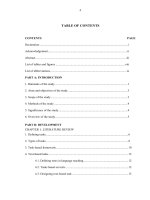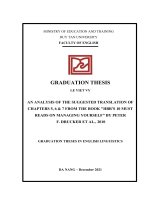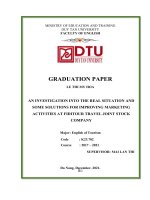translation difficulties and some solutions for k65s third year students of sofl
Bạn đang xem bản rút gọn của tài liệu. Xem và tải ngay bản đầy đủ của tài liệu tại đây (1.55 MB, 26 trang )
<span class="text_page_counter">Trang 1</span><div class="page_container" data-page="1">
<b>HANOI UNIVERSITY OF SCIENCE AND TECHNOLOGYSCHOOL OF FOREIGN LANGUAGES</b>
<b>Hanoi, July</b>
0
</div><span class="text_page_counter">Trang 2</span><div class="page_container" data-page="2"><b>FL3080 Research MethodologyResearch Findings and Discussion</b>
Group No.: 5 <b>Topic: Translation difficulties and some solutions for K65’s third-year students of SOFL</b>
Date of Submission: 25/07/2023Group members and ID (alphabet order) In charge of Part number
<i>1. Nguyen Thi Ngoc Anh 20204053<sup>3.2; 3.2.1;3.2.3; 3.2.4 </sup>2. Truong Thi Lan Anh 20204058<sup>Introduction; 4.3; 5 </sup>3. Bui Thi Minh Hong 20204092<sup>1; 3.1; 3.2.2; 3.2.4 </sup>4. Duong Thi Thanh Tra 20204173<sup>2; 4.1; 4.2; Conclusion</sup></i>
<i>Group Work</i>
<i>Research objectives, Research questions,Research methods, Data collection instrument,Questionnaire survey, Summary of Data</i>
<b>Research objectives:</b>
<i>In this study, we will focus on pointing out the issues of the 3rd-year SOFL’s students inlearning both Vietnamese- English and English – Vietnamese translation. In which we willfocus on showing the most frequent difficult translation problems encountered by studentsmajoring in English for Science and Technologies, and the most typical translationtechniques employed by most students. Then, we decide to suggest some relevant solutionsthat can help students improve their translation skills. Besides, lecturers andadministrators can use these results to make essential adjustments to the course.</i>
<b>Research questions</b>
<i>In this study, the researchers aim to address the following questions:</i>
<i>1. What difficulties did SOFL’s students experience during the translation process?2. Which factors are causing the problems?</i>
<i>3. What are some solutions to assist students overcome these challenges?</i>
<b>Research methods</b>
<i>This study was conducted using a mixed-methods approach, </i>which includes both qualitativeand quantitative research. <i>We choose a questionnaire survey as major instrument because we need to gather a large amount of data from students of third year SOFL’s students who studied the translation module. The online questionnaire survey included 10 pre-coded </i>
1
</div><span class="text_page_counter">Trang 3</span><div class="page_container" data-page="3">3.1. Type of difficult text for translation3.2. Problems while translating process
3.2.1. Linguistic challenges
3.2.2. Cultural differences
3.2.3. Personal challenges
3.2.4. Difficulties when dealing with differences in grammatical structures (MH, NA)
<b>4. Strategies utilized by students to overcome difficulties</b>
4.1 Strategies used to deal with non-equivalence at word level4.2 Strategies used to deal with idioms and fixed expressions4.3 Strategies used to deal with differences in grammatical structures
<b>5. Student’s opinion about essential skills for translators in the upcoming yearsCONCLUSION</b>
2
</div><span class="text_page_counter">Trang 4</span><div class="page_container" data-page="4">This research was conducted at Hanoi University of Science and Technology, School ofForeign Language (SOFL), using a mixed-methods approach. The quantitative approach willbe used in the first 10 pre-coded questions in a the self-completed survey designed for thethird-year students of SOFL who have studied the first translation module in Google Form.This questionnaire form includes 1 open-ended question which used the qualitative approach.These questions are based partly on the research “Students’difficulties in translating Englishtext” published in 2019 by Arono and Nadrah.
Our research had the responders of 100 students majoring in English for Science andTechnology and Professional International English from K65 SOFL. On June 25, 2023, wesent our surveys to 100 students. Each person's survey-taking time was between three and fiveminutes. Our research team made it clear to the participants that their answers would be keptprivate. These students are also encouraged to indicate other challenges that they haveencountered while studying translation along with our own pre-coded questions.
We choose a questionnaire survey as the instrument of research method because we need togather a large amount of data from students. We select the questionnaire survey as an idealinstrument for gathering data because they guarantee a high response rate, and occupy lesstime, which makes it simple for our team researchers to compare all responses to individualresponses. We can rapidly gather enormous amounts of information from numerous people ina short length of time using an online form and mobile application. Our team collected 100responders in about one week. Furthermore, the online tools make it simple to assess theresults without a background in statistics or scientific research. To provide the greatest levelof privacy and anonymity, we also integrated the questionnaire survey with Google Forms.Furthermore, we see that when respondents complete the survey anonymously, the results areconsiderably more accurate. Besides, we arrange the survey questions such that responderscan quickly scan the information and provide the most accurate responses. There have been10 pre-coded questions and 1 open-ended question in the online questionnaire survey.Online Survey – Respondent Completed
The survey is designed to study the experiences of students about learning the Translation course. It is being conducted by means of a Google Form, involving a respondent-completed questionnaire distributed to K65 SOFL third-year students.
3
</div><span class="text_page_counter">Trang 5</span><div class="page_container" data-page="5">Translation Learning Survey
Dear fellow students, we are a group of third-year students at School of ForeignLanguages (SOFL), Hanoi University of Science and Technology. We are conducting thisresearch to discover challenges and solutions for SOFL’s third-year students in learningTranslation. We sincerely appreciate your attention in our research. The data will be onlyused for our research and all personal information will be kept private.
1. What score did you obtain on the first translation module?A. Weak (<4.0) B. Below average (4.0-5.4)
C. Average (5.5-6.9)D. Good (7.0-8.4)E. Very good (8.5-10)2. How long did you spend on
practicing your translating per day?A. Less than 30 minutes
B. 1 hour – 2 hoursC. More than 2 hoursD. Hardly ever
3. In your opinion, which type of text is the most difficult in translating?
A. Vietnamese – EnglishB. English – VietnameseC. The degree of difficulty is the
same.D. Others:
4. What problems did you encounter while translating?
A. Cultural differencesB. Linguistics challengesC. Personal challenges
5. What CULTURAL problems did you encounter while learning translation?
A. The source language cultural terms which are semantically complex.B. Finding suitable cultural equivalent
terms in target language.C. There are no cultural equivalent
terminologies in target language.D. Understanding cultural differences in the
source language and the target language.E.Others:
6.What LINGUISTIC CHALLENGES did you encounter while learning translation?
A. Structure of sentences in English and target language are different.B. Understanding meaning of words,
collocations, idioms, slang, proper noun, phrasal verbs, complex phrasal verbs.C. Analyzing context of source language
and translating proper noun.
D. Finding equivalent words, phrasal verbs, idioms, collocation, slangs, …in target languages.
E. Others:
7.What PERSONAL CHALLENGES did 4
</div><span class="text_page_counter">Trang 6</span><div class="page_container" data-page="6">you encounter while learning translation?
A. Limited time (cannot control translation speed)
B. Laziness
C. Health (Some people are unable to use computers for extended periodsof time to practice translating.)D. Others:
8. What are the STRATEGIES that you normally use when dealing with non-equivalence at word level?
A. Translation by a more specific word
B. Translation by a more general word
C. Translation by cultural substitutionD. Translation by using a loan word
plus explanationE. Translation by paraphraseF. Translation by omission9. What are the STRATEGIES that
you normally use when dealing with idioms and fixed expressions?A. Using an idiom or fixed expression
of similar meaning and formB. Using an idiom or fixed
expression of similar meaning but dissimilar form
C. Translation by paraphraseD. Translation by omission
10. What are the categories that you normally find difficult when dealing with differences in grammatical structures?A. Voice (active and passive)B. Number (plurality)C. Person (personal pronouns)D. Others:
11. In your opinion, what skills are essential for translator in the upcoming years?
5
</div><span class="text_page_counter">Trang 7</span><div class="page_container" data-page="7">6
</div><span class="text_page_counter">Trang 11</span><div class="page_container" data-page="11"><b>Number%Sample size </b>
<b>Score of the first translation module </b>
Weak (<4.0)
Below average (4.0-5.4) Average (5.5-6.9) Good (7.0-8.4) Very good (8.5-10)
<b>Time spent on practicing translation per day</b>
Less than 30 minutes 1 hour – 2 hours More than 2 hours Hardly ever
<b>Type of text found difficult for translation </b>
Vietnamese – English English – Vietnamese
The degree of difficulty is the same
<b>Problems while translating </b>
Cultural differences Linguistics challenges Personal challenges
<b>Cultural problems while learning translation </b>
Semantically complex source language cultural terms Could not find suitable cultural equivalent terms No cultural equivalent terminologies Understanding cultural differences
<b>Linguistic challenges while learning translation </b>
Different structures of sentences between languages Understanding meaning of words, collocations, idioms… Analyzing context of source language and translating proper
<b>100 </b>
5 4 26 51 14
36 32 17 15
52 18 30
76 84 49
67 68 57 57
44 66 55
5% 4% 26% 51% 14%
36% 32% 17% 15%
52% 18% 30%
76% 84% 49%
67% 68% 57% 57%
44% 66% 55%
0
</div><span class="text_page_counter">Trang 12</span><div class="page_container" data-page="12">noun
Finding equivalent words, collocations, idioms…
<b>Personal challenges while learning translation </b>
Limited time Laziness Health
<b>Strategies normally used when dealing with equivalence at word level </b>
non-Translation by a more specific word Translation by a more general word Translation by cultural substitution
Translation by using a loan word plus explanation Translation by paraphrasing
<b>Difficulties when dealing with differences in grammaticalstructures </b>
Voice (active and passive) Number (plurality) Person (personal pronouns) Relative clause
71
66 79 19
43 59 53 58 67 29
62 73 68 25
71 40 47 1
71%
66% 79% 19%
43% 59% 53% 58% 67% 29%
62% 73% 68% 25%
71% 40% 47% 1%
1
</div><span class="text_page_counter">Trang 13</span><div class="page_container" data-page="13">Translation is a relatively challenging and demanding module. It is notsurprising that many students, especially SOFL students who have just familiarizedthemselves with this module are struggling with finding a way to have an effectivetranslation. Aware of that, our group decided to conduct a questionnaire survey sent toSOFL’s third-year students to find out what problems they are dealing with whiletranslating, what causes those challenges, and strategies they are using to solve them.From that, we could capture a panorama of the translation’s obstacles that studentsmust overcome and then offer them some appropriate translating strategies.Fortunately, our survey has gotten 100 responses. All results are listed below.
<b>DATA ANALYSIS</b>
<b>1.The score of the first translation module</b>
<b>Score of the first translation module </b>
Weak (<4.0) Below average (4.0-5.4) Average (5.5-6.9)Good (7.0-8.4) Very good (8.5-10)
<i>Figure 1: The Score of The First Translation Module</i>
Previously, the<b> outcomes in the first translation module are shown in the chart</b>
above. In the above pie chart, students who got good score (around 7.0 - 8.4) is themode. In particular, more than half (51%) received a good grade, 14% got a very goodmark and 26% were on average. Only 4 students had below-average scores, and 52
</div><span class="text_page_counter">Trang 14</span><div class="page_container" data-page="14">students obtained weak scores, which accounted for 4% and 5% of the total number ofstudents that responded. There are some explanations for the results achieved by K65students. To begin with, it is noteworthy that the majority of students in the firsttranslation module received “good grades (around 7.0 - 8.4)”. This is a promisingresult because the students have approached translation from the most fundamentallevel, such as translating dialogue and translating text. They received their firstopportunity to approach the professional translation process during the previoussemester while learning the theory of translation. As a result, K65 students' score thissemester is high. However, it should be emphasized that only 14% of the studentsachieved the classification of "very good" (scores ranging from 8.5 to 10), whichsuggests a relatively low level of proficiency in the practical application of theoreticalknowledge and principles. This finding implies that students may encounter challengesin specific areas of translation practice, indicating the need for continued developmentin certain areas.
<b>2.The average time students spent on practicing translation</b>
<b>Average time spent on practicing translation per day </b>
Less than 30 minutes 1 hour – 2 hoursMore than 2 hours Hardly ever
<i>Figure 2: The average time students spent on practicing translation</i>
According to the data in the previous pie chart, K65 students have obtained asignificant number of high scores for the translation module. Therefore, it is no surprise that85% of students spend time daily practicing translation. Figure 2 illustrates the average timestudents practice translation per day. Specifically, only 17% of the students spent more than
3
</div><span class="text_page_counter">Trang 15</span><div class="page_container" data-page="15">two hours practicing translation, and 32% spent between 1 and 2 hours. However, more than athird of the students (36%) only spent less than 30 minutes practicing which is the mode. It isstill alarming that 15% of students spend little time each day practicing translation. Spendingmore than an hour practicing each day is essential for professional language learners. As itassists students in gradually strengthening their linguistic weaknesses. There are severalpossible explanations for why students hardly practice translation, including the fact they arenot interested in available practicing translation materials and their laziness. To spur students'enthusiasm for learning translation, instructors might also keep an eye on and update newtranslation resources and methods.
<b>3. Students’ challenges in the first translation module3.1. Type of difficult text for translation</b>
<b>Type of difficult text for translation</b>
Vietnamese – English English – Vietnamese The degree of difficulty is the same
<i>Figure 3: Type of difficult text for translation</i>
The pie chart above demonstrates problems encountered by students depend mainlyon the source language of the material. Vietnamese-English and English-Vietnamese textsare two instances of challenging texts to translate. Over half of the students (52%) foundthe translation from Vietnamese to English to be more problematic, whereas only 18%found the translation from English to Vietnamese to be more challenging, and theremaining 30% found the degree of difficulty is the same. The number of 52% indicatesthat translating from Vietnamese to English is currently the most challenging task for K65SOFL students. The fundamental reason is that English linguistic students at HUST aremore interested in translating scientific and technological academic materials. However,most Vietnamese scientific publications are difficult to understand and translate. Students
4
</div>








